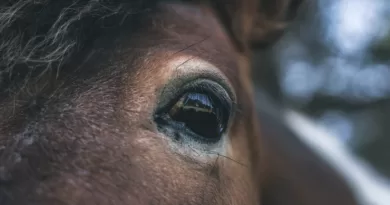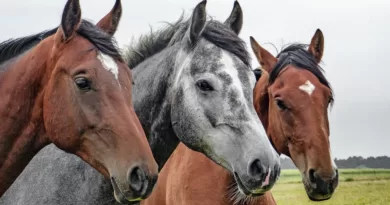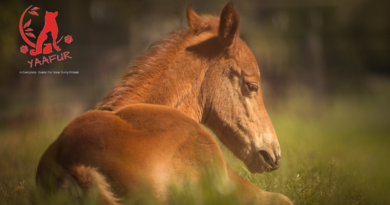How Big Is a Horse’s Brain
Understanding the Anatomy of a Horse’s Brain
The anatomy of a horse’s brain is a fascinating topic that sheds light on the inner workings of these majestic creatures. Comprising various structures, the horse’s brain is responsible for controlling and coordinating its bodily functions, as well as processing information from its environment. One of the most prominent features of a horse’s brain is its size. With an average weight of approximately 1 kilogram, the horse’s brain is relatively large compared to other animals of similar stature. This larger brain allows horses to possess a higher level of cognitive abilities and adaptability.
When dissecting a horse’s brain, several key regions stand out. The cerebral cortex, located at the outermost layer, plays a crucial role in higher cognitive functions such as learning, memory, and decision-making. Beneath the cortex lies the hippocampus, responsible for spatial navigation and memory formation. The thalamus acts as a relay station, transmitting sensory information to various parts of the brain, while the cerebellum coordinates movement and balance. Additionally, the brainstem, consisting of the midbrain, pons, and medulla, controls the horse’s basic bodily functions, such as breathing and heart rate. Understanding the intricate anatomy of a horse’s brain gives us valuable insights into their remarkable capabilities and behavior.
The Structure and Function of a Horse’s Brain
The horse’s brain is a highly complex and organized structure, responsible for controlling and coordinating all of the animal’s bodily functions. Similar to the human brain, it is composed of various regions that serve specific functions. At the core of the horse’s brain lies the brainstem, which acts as a bridge between the spinal cord and the higher brain regions. This region is responsible for regulating essential processes such as breathing, heart rate, and digestion.
Moving towards the front of the brain, we find the cerebral cortex, which is responsible for the horse’s higher cognitive functions. It is in this region that sensory information is processed, and motor commands are initiated. Notably, the cerebral cortex is also involved in memory, learning, and decision-making processes. These functions play a crucial role in a horse’s ability to learn new commands, solve problems, and adapt to different situations. Overall, the structure and function of a horse’s brain reflect its evolutionary adaptations and provide unique insight into their cognitive abilities and behaviors.
Comparative Size: How Does a Horse’s Brain Measure Up?
The size of a horse’s brain is an intriguing subject for scientists and animal enthusiasts alike. In terms of sheer size, the horse’s brain is relatively large compared to many other species. On average, a horse’s brain weighs approximately 600 grams, which is significantly heavier than the brains of smaller mammals but lighter than those of larger mammals. However, it is important to note that brain size does not necessarily determine intelligence or cognitive capabilities.
When comparing the size of a horse’s brain to its body, some interesting insights emerge. The brain-to-body ratio, known as the encephalization quotient (EQ), provides a measure of relative brain size. Horses have an EQ of around 0.6, meaning their brain size is proportionate to their body size. This is similar to other large land mammals and suggests that horses have evolved to possess a brain that efficiently supports their physical capabilities and behavioral needs. As animals shaped by millions of years of evolution, horses have adapted their brain size to suit their unique physiological and ecological requirements.
The Evolutionary Adaptations of a Horse’s Brain
Evolutionary adaptations play a crucial role in shaping the structure and function of a horse’s brain. Over millions of years, horses have undergone significant changes, allowing them to thrive in various environments. One remarkable adaptation is the enlargement of their cerebral hemispheres, which are responsible for higher cognitive functions. This enlargement has enabled horses to develop advanced sensory processing and motor coordination skills, contributing to their agility and survival in the wild.
Additionally, horses’ brains have evolved to specialize in perceiving and interpreting their surroundings accurately. They possess exceptional visual memory, enabling them to recognize familiar landscapes and navigate effectively across vast territories. Moreover, their brain’s olfactory system has become highly developed, aiding in detecting predators or locating potential sources of food. These evolutionary adaptations highlight the remarkable resilience of these majestic creatures, illustrating how their brains have been finely tuned to adapt to their ecological niches.
Exploring the Different Regions of a Horse’s Brain
The brain of a horse, like that of any other animal, is a complex organ composed of various regions that work together to control different functions. One of the main regions in a horse’s brain is the cerebrum. This is the largest part of the brain and is responsible for higher cognitive processes, such as learning, memory, and decision-making. Within the cerebrum, there are different areas responsible for sensory perception, motor control, and language processing. Understanding the different regions of the horse’s cerebrum can provide valuable insights into their cognitive abilities and behavior.
Another important region in a horse’s brain is the cerebellum. This area is located at the back of the brain and is responsible for coordinating and regulating movements. The cerebellum plays a crucial role in maintaining balance and posture, as well as in fine-tuning motor skills. It receives information from sensory receptors throughout the body and integrates this information to ensure smooth and coordinated movements. Exploring the structure and function of the cerebellum in horses can help us better understand their athleticism and agility.
Cognitive Abilities: What Can a Horse’s Brain Do?
Horses possess a remarkable set of cognitive abilities that enable them to navigate and interact with their environment. One such ability is their excellent spatial memory, which allows them to remember complex routes and landscapes even after extended periods of time. This cognitive skill is particularly useful for horses in the wild, as it enables them to find food, water sources, and shelter in their ever-changing surroundings.
In addition to spatial memory, horses also exhibit an impressive ability to recognize and remember human faces. Research has shown that horses can recognize familiar faces, even if they have not seen that person for a considerable period of time. This cognitive ability is crucial for horses in domesticated settings, as it allows them to form strong social bonds with their caretakers and better understand their intentions and emotions. Understanding the extent of these cognitive abilities sheds light on the level of intelligence and adaptability that horses possess.
Emotional Intelligence: Insights into a Horse’s Brain
Horses are highly intelligent and sensitive animals, and their emotional intelligence plays a crucial role in their interactions with humans and other horses. Studies have shown that horses possess a remarkable ability to perceive and respond to the emotional states of those around them, including humans. This emotional sensitivity is thought to be rooted in the horse’s limbic system, which is responsible for regulating emotions and processing sensory information.
Research has demonstrated that horses are capable of recognizing and interpreting human facial expressions, voice tones, and body language, allowing them to gauge the emotional state of their human counterparts. This understanding of human emotions enables horses to establish strong bonds with their riders, as they can sense and respond to their rider’s emotions, providing comfort and support when needed. Furthermore, horses can also display empathy towards other horses, offering solace and reassurance during times of stress or discomfort.
By understanding the emotional intelligence of horses, we can enhance our interactions and relationships with these magnificent creatures. It becomes important for horse owners, trainers, and riders to be aware of their own emotional state and learn to communicate effectively with their horses, using signals that horses naturally respond to. This fosters a deep connection built on trust and mutual understanding, creating a harmonious partnership between humans and horses.
• Horses possess a remarkable ability to perceive and respond to the emotional states of those around them, including humans.
• This emotional sensitivity is thought to be rooted in the horse’s limbic system, which regulates emotions and processes sensory information.
• Research has shown that horses can recognize and interpret human facial expressions, voice tones, and body language.
• Horses can establish strong bonds with their riders by sensing and responding to their emotions, providing comfort and support when needed.
• Horses also display empathy towards other horses, offering solace during times of stress or discomfort.
• Understanding the emotional intelligence of horses allows us to enhance our interactions and relationships with them.
• Horse owners, trainers, and riders should be aware of their own emotional state and learn effective communication techniques with horses.
• By using signals that horses naturally respond to, we can build trust and mutual understanding for a harmonious partnership between humans and horses.
The Role of the Brain in Horse Behavior and Communication
Horses are highly social animals that rely on complex behaviors and communication to navigate their environment and interact with others. At the core of these abilities lies the intricate wiring and functioning of their brains. The brain plays a vital role in shaping a horse’s behavior, influencing everything from their response to stimuli to their ability to learn and problem-solve.
One key aspect of horse behavior that is influenced by the brain is their social dynamics. Horses are herd animals, and their brains have evolved to be highly attuned to social cues. This allows them to form strong social bonds, establish hierarchies within the herd, and communicate with one another effectively. Through a combination of verbal and non-verbal communication, such as vocalizations, body language, and facial expressions, horses are able to convey messages and maintain social harmony within their groups. The brain processes and interprets these signals, allowing horses to respond appropriately to the social cues of their herd mates. Understanding the role of the brain in horse behavior and communication is crucial for anyone working with or caring for these animals, as it provides insights into their social needs and helps promote positive relationships between horses and humans.
Neurological Disorders and Diseases in Horses
Neurological disorders and diseases are a common concern among horses, as they can severely impact their overall health and well-being. One such disorder is Equine Protozoal Myeloencephalitis (EPM), which is caused by a parasite that affects the central nervous system. Horses infected with EPM may exhibit a range of symptoms, such as muscle atrophy, imbalance, and weakness. Early detection and prompt treatment are crucial in managing this condition and minimizing its impact on the horse’s quality of life.
Another neurological disease that affects horses is Equine Herpesvirus (EHV), which can lead to respiratory infections and neurological complications. EHV-1, in particular, has been associated with equine abortion and neurological disorders, presenting symptoms like fever, weakness, and loss of coordination. Proper vaccination, biosecurity measures, and quarantine protocols play a crucial role in preventing the spread of EHV and mitigating its potential impact on the equine population. Timely diagnosis and treatment are vital for reducing the severity of symptoms and improving the horse’s chances of recovery.
Promoting Equine Brain Health and Well-being
One of the key ways to promote equine brain health and well-being is through proper nutrition. A balanced diet that includes essential nutrients such as vitamins, minerals, and omega-3 fatty acids is vital for optimal brain function in horses. Providing access to high-quality forage, such as pasture or hay, is essential, as horses are herbivores and rely heavily on these sources for their nutritional needs. Additionally, ensuring that horses have access to clean water at all times is crucial for their overall health, including brain function.
Regular exercise is also important for promoting equine brain health. Just like humans, horses benefit from regular physical activity that gets their blood pumping and stimulates their brain. Engaging in activities such as riding, lunging, or turnout not only helps to keep horses physically fit but also stimulates their minds and helps prevent boredom. Mental stimulation is equally important for promoting brain health in horses. Incorporating activities that challenge their problem-solving skills, such as puzzles or training exercises, can help keep their brains sharp and engaged.
By focusing on proper nutrition, regular exercise, and mental stimulation, horse owners can play a significant role in promoting equine brain health and ensuring the overall well-being of their horses.
What is the anatomy of a horse’s brain?
The anatomy of a horse’s brain refers to its structure and organization. It consists of different regions, such as the cerebrum, cerebellum, and brainstem, each responsible for various functions.
How does a horse’s brain compare in size to other animals?
In terms of brain size relative to their body, horses have a relatively large brain compared to other animals. However, their brains are smaller than those of humans and some other mammals.
What are the evolutionary adaptations of a horse’s brain?
The horse’s brain has undergone evolutionary adaptations to support its survival in the wild, such as increased sensory processing abilities and motor coordination.
What are the different regions of a horse’s brain?
The different regions of a horse’s brain include the cerebrum, which is responsible for higher cognitive functions, the cerebellum, which controls motor coordination, and the brainstem, which regulates basic bodily functions.
What cognitive abilities does a horse’s brain possess?
A horse’s brain is capable of various cognitive abilities, including learning, memory, problem-solving, and spatial awareness.
Does a horse’s brain have emotional intelligence?
Yes, horses have emotional intelligence. Their brains enable them to experience and express a wide range of emotions, including fear, happiness, and stress.
What role does the brain play in horse behavior and communication?
The brain plays a crucial role in horse behavior and communication. It influences their instincts, social interactions, and ability to interpret and respond to signals from other horses and humans.
What are some neurological disorders and diseases that can affect horses?
Horses can suffer from neurological disorders and diseases such as equine encephalitis, equine protozoal myeloencephalitis (EPM), and equine motor neuron disease, which can affect their brain health and overall well-being.
How can we promote equine brain health and well-being?
Promoting equine brain health and well-being involves providing a stimulating and enriched environment, proper nutrition, regular exercise, social interaction, and regular veterinary check-ups to prevent and manage any neurological disorders or diseases.




